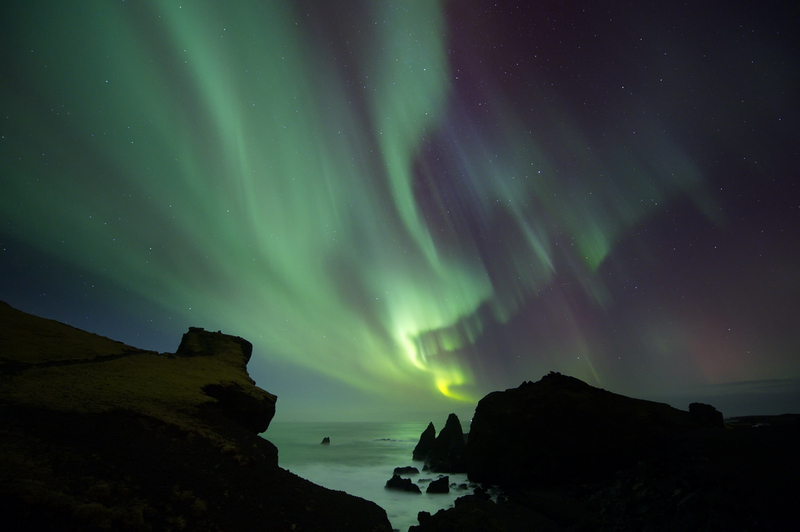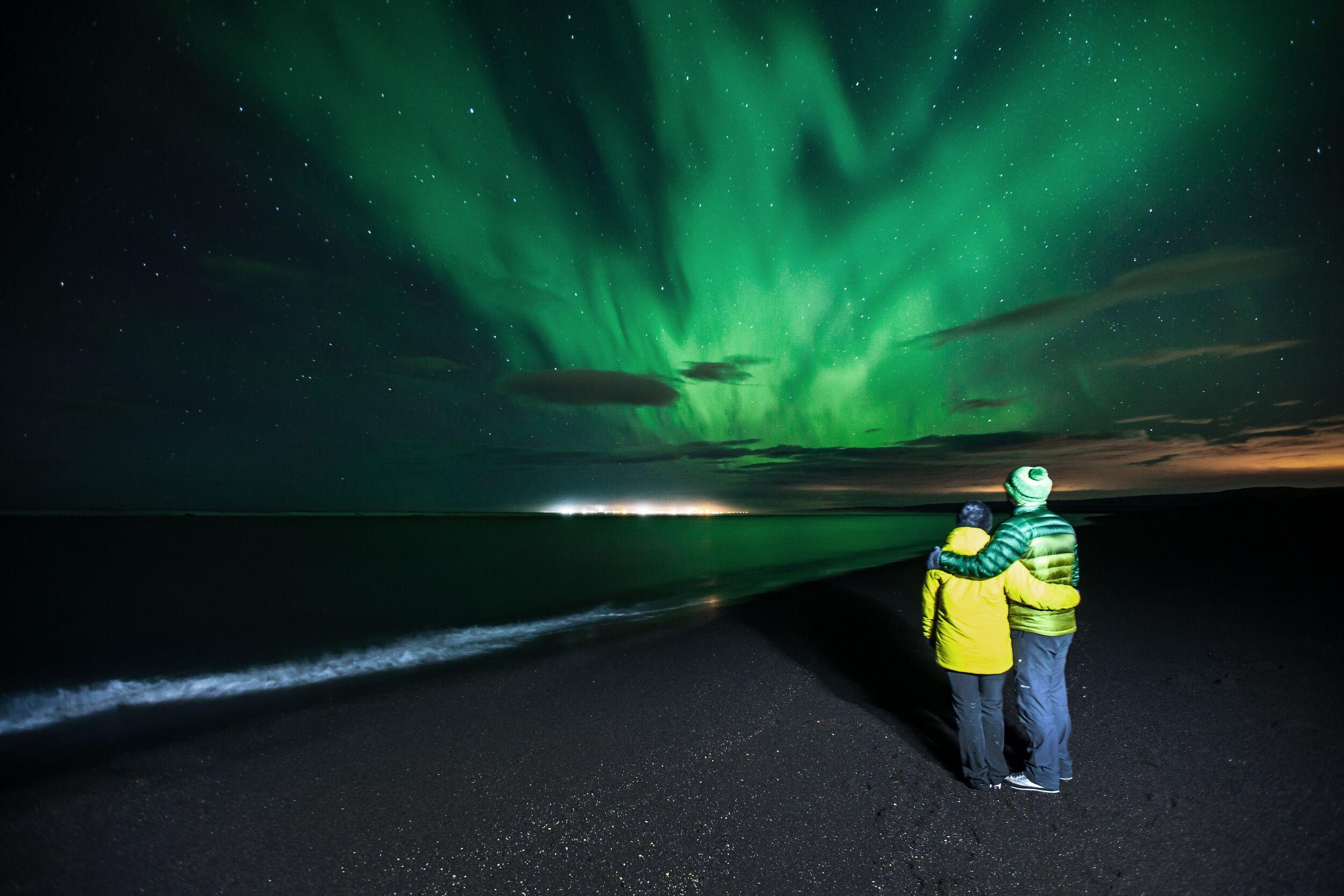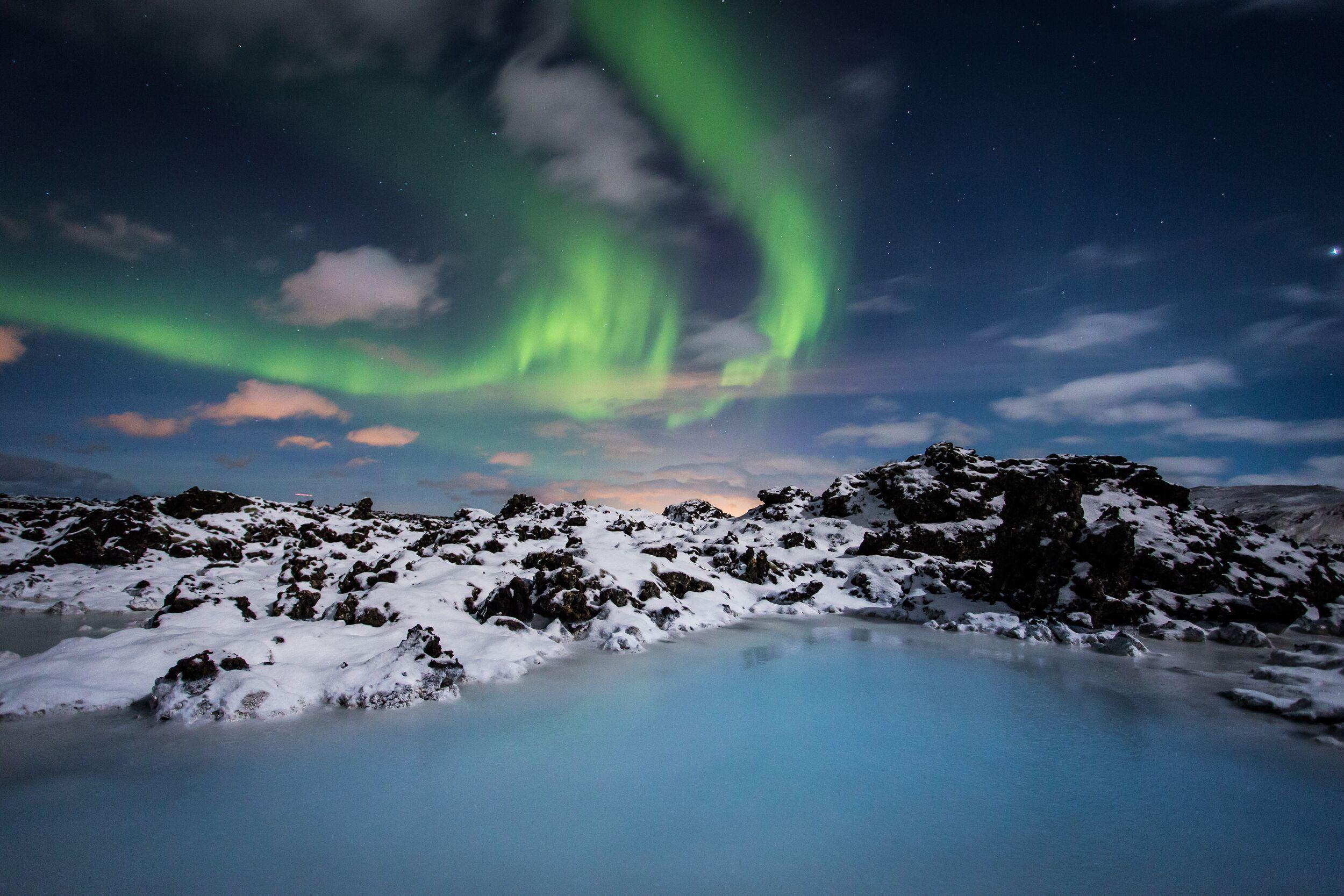Why Choose a Northern Lights Tour?
The Northern Lights are one of those things that people have dreamed of seeing for as long as they can remember. And they really are that special. Imagine gazing up at the night sky to see these shimmering extraterrestrial lights in the midst of a snow-covered landscape.
On a Northern Lights tour in Iceland, you no longer have to imagine. Our tours take you to the best spots to see this unforgettable sight. And along the way, our local guides will share the magic and science behind their awesome colours.

The Enchantment of Northern Lights
Perhaps you know that the Northern Lights are caused by activity on the sun already. When there are storms on the sun’s surface, solar particles fly across the Solar System and crash into Earth’s atmosphere. It’s those collisions that cause the incredible lights you’ll see.
But there’s so much more to learn—and there’s nothing like seeing the display for yourself. Join one of the best Northern Lights tours in Iceland to get the answers to your questions, expert photography tips, and great company to make the experience complete.

Northern Lights Tours with Icelandia
But there’s so much more to learn—and there’s nothing like seeing the display for yourself. Join one of the best Northern Lights tours in Iceland to get the answers to your questions, expert photography tips, and great company to make the experience complete.
At Icelandia, we offer tours to suit a range of styles and travel plans. For example, are you looking for a Northern Lights tour from Reykjavík? We can pick you up from your accommodation and take you out of town to where the conditions will be the best. It’s one of the most popular tours in Iceland.

Northern Lights Combo Tours
Alternatively, would you prefer to see the Northern Lights while exploring the incredible destinations along Iceland’s south coast? We offer Northern Lights tours to the Snæfellsnes Peninsula and the Golden Circle.
Or combine a Northern Lights experience with a serene trip to a spa. Whether you choose the Blue Lagoon, the Sky Lagoon, or the Fontana Geothermal Baths, it promises a truly special evening.
FAQ:
Almost any camera phone these days is powerful enough to take decent pictures of the Northern Lights. In fact, many phone cameras are actually better than proper cameras!
To take a good photo, turn your exposure to the maximum, turn off the flash, and use night mode. Apps such as Nightcap, Cortex Camera, or the Northern Lights Photo Taker can help too.
The rarest colours of the Northern Lights are blue and red. Blue auroras are produced by nitrogen molecules at lower altitudes and are less common. Red auroras, occurring at the highest altitudes and caused by high-altitude oxygen, are also relatively rare. Both these colours require specific atmospheric conditions to be visible, making them a less frequent but spectacular sight in auroral displays.
The Northern Lights can be seen from Reykjavík, yes. And it’s a magical experience to see them by chance when you’re just enjoying your evening.
However, the city is not the best place to see the Northern Lights. That’s because light pollution can prevent them from appearing with their full strength. Instead, you want somewhere dark to enjoy them at their best.
The Northern Lights are special for a couple of key reasons:
1. Unique Natural Phenomenon: They represent a spectacular natural light display in the Earth's sky, primarily seen in high-latitude regions around the Arctic and Antarctic. This phenomenon results from the interaction between the Earth's magnetic field and charged particles from the sun, making it a unique celestial event.
2. Cultural and Mythological Significance: Throughout history, the Northern Lights have held significant cultural and mythological importance in various societies. They have inspired numerous folklore tales and art and have been a subject of awe and wonder. Their ethereal beauty and the magical experience they provide add to their special status in human perception and experience.
It’s possible to see the Northern Lights in Iceland throughout the winter.
For the Northern Lights to be visible, you need two things: solar activity and a clear, dark sky. The darker the better—that’s why winters in very northern countries like Iceland are the best time to see them.
The darkest months of the year are November, December, and January. However, you can see Northern Lights from the middle of August through to April and studies show that the closer you are to the equinoxes, the higher the likelihood of seeing the Northern Lights. Based on that you'd want to place your bet on September/October and March/April.
The scientific processes that cause the Northern Lights occur very often, if not pretty much all the time—throughout the night, day, winter and summer. However, often you can’t see them because of the cloud, the midnight sun, or because you’re not looking.
While every night might be an exaggeration, the Northern Lights are much more common than you might think!
Auroras can last from a few minutes to several hours, depending on the intensity of the geomagnetic storm causing them.
To maximize your chances of seeing the Northern Lights, it's advisable to stay for at least a week. This duration allows for variability in weather conditions and solar activity, which are crucial factors in the visibility of the auroras. Since the Northern Lights are a natural phenomenon and their appearance can be unpredictable, a longer stay increases the likelihood of witnessing this spectacular display, especially considering potential cloudy nights or periods of low solar activity.
Facing north often increases your chances of seeing the Northern Lights, especially in lower-latitude areas. In Iceland, however, the lights are most often right above our heads or stretching across the entire sky.
There’s no way of guaranteeing that you’ll see the Northern Lights. It’s a natural phenomenon that’s affected by the weather, after all. But with Northern Lights tours, you do have a pretty good chance.
In Iceland, December is the month when the days are shortest and nights are darkest which typically makes it a favourite month for Northern Lights-hunting. However, studies show that the closer to the equinoxes you are, all the more likely you are to see northern lights in the northern hemisphere. So, some would prefer September and October or March and April over the darkest months, sacrificing a few hours of darkness for a higher likelihood of lights.
That said, you can have as much luck seeing the aurora borealis in any of the months of the winter. All you need is dark, clear skies.
Exciting studies and anecdotal evidence, ranging from Sami folklore to modern stargazers, suggest that the Northern Lights might produce sounds, a phenomenon as elusive as the lights themselves.
Historically, indigenous peoples and early Arctic explorers reported hearing sounds like crackling and whooshing during auroral displays, though these claims were met with scepticism since auroras occur at altitudes beyond the human ear's acoustic range.
Recent research in Finland, however, has recorded sounds such as claps and crackles coinciding with the auroras at lower altitudes within the human audible range. This emerging theory suggests that the electrical phenomena of auroras, involving charged particles and temperature variations, could generate these sounds akin to the noise produced by a spark.
While not all observers experience these sounds, and they're often heard under specific, quiet conditions, for some, the Northern Lights are not just a visual spectacle but a celestial concert, highlighting the dynamic nature of our planet.
Yes, you can see the Northern Lights in Reykjavik in some cases. However, when the lights are faint or low on the horizon, their visibility can be significantly reduced by the city lights and obstructed by buildings. For the best viewing experience, it's recommended to find spots away from the urban light pollution and with an unobstructed view of the sky.
It’s not at all rare to see the Northern Lights in Iceland! That’s why so many people come to the Land of Ice and Fire to enjoy the display.
In fact, you can see the aurora borealis almost every night if the skies are clear. You just need to know where to look!
The best way to increase your chances of seeing the Northern Lights is to join a tour. While you can sometimes see the phenomenon by yourself, when you’re led by an expert guide, they’ll be able to show you exactly where to look.
What’s more, if you don’t see the Northern Lights on your tour, we’ll give you a ticket to another tour on a day that suits you for free—to double your chances.
Three interesting facts about the Northern Lights are:
1. The Northern Lights, also known as Aurora Borealis, are caused by the interaction of solar wind - a stream of charged particles escaping the Sun - with Earth's magnetic field and atmosphere.
2. They can exhibit a variety of colours, with green being the most common. These colours result from different gases in the atmosphere getting excited by the solar particles; oxygen emits green and red hues, while nitrogen gives off blue and purple.
3. Although best known for appearing in polar regions, during periods of strong solar activity, the Northern Lights can be seen at lower latitudes, far from the polar areas. This makes them a spectacular and somewhat unpredictable natural light show.
To see the Northern Lights at their best, it’s recommended that you find a place where light pollution is lowest. That’s why the best Northern Lights tours will leave cities such as Reykjavík—because you can see the aurora better where it’s darkest.
That said, you can see the Northern Lights from the city. And as weather conditions and cloud cover change every night, the best place to see the Northern Lights changes too.
Seeing the Northern Lights in Iceland is fairly likely during the winter months if weather conditions are favourable.
The price of Northern Lights tours in Iceland depend on what you want to get up to and how you want to travel.
The most affordable option is the classic tour from Reykjavík, which takes you by coach to a destination where the conditions are best that evening. But if you want to travel by small group, or on a private vehicle, you will pay more.
The same goes for tours that take you to different destinations, such as the Golden Circle or the Blue Lagoon.
Check out individual tour pages for up to date prices.
The Northern Lights do not occur every night; their visibility depends on solar activity and atmospheric conditions.
The Northern Lights are not exclusively in the north; they are mirrored by the Southern Lights (Aurora Australis) in the southern hemisphere, both occurring near the Earth's magnetic poles.
When on a Northern Lights tour, plan to wear clothes that will best keep you warm. You’re going to be outside at night in the Icelandic winter, and to enjoy the experience to the fullest you won’t want to get cold.
The best idea is to wear lots of thin layers, plus a winter jacket and a windproof outer shell. And don’t forget to keep your feet warm! Icelandic woollen socks, for example, can be a good idea.
The best parts of Iceland for Northern Lights are outside urban areas, with the eastern northern and western regions often recommended for clearer skies.

